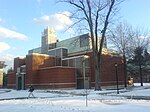Casperkill
Oral historyPoughkeepsie, New YorkRivers of Dutchess County, New YorkRivers of New York (state)Tributaries of the Hudson River

The Casperkill (also known as Jan Casper's Kill and shown on federal maps as Casper Creek) is a creek in both the town and city of Poughkeepsie, Dutchess County, New York. It flows 11.6 miles (18.7 km) from Peach Hill Park to the Hudson River. Combined with its only major tributary, the Fonteyn Kill, it forms a 12 sq mi (31 km2) subwatershed. It lies entirely within the British royal grant of 1685 known as the Rombout Patent.
Excerpt from the Wikipedia article Casperkill (License: CC BY-SA 3.0, Authors, Images).Casperkill
Brewers Lane, Town of Poughkeepsie
Geographical coordinates (GPS) Address Nearby Places Show on map
Geographical coordinates (GPS)
| Latitude | Longitude |
|---|---|
| N 41.688055555556 ° | E -73.890833333333 ° |
Address
Vassar College
Brewers Lane
12604 Town of Poughkeepsie
New York, United States
Open on Google Maps









